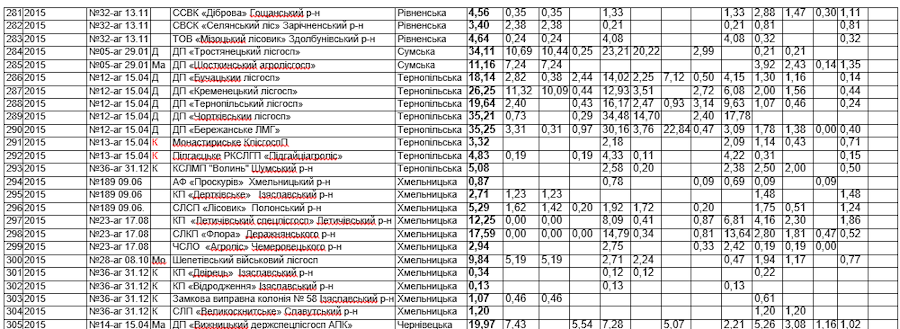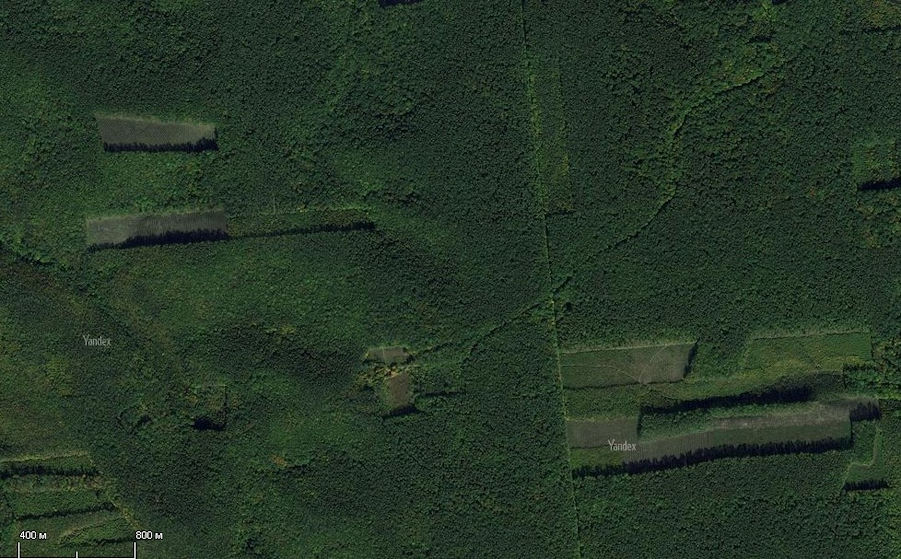According to the Forest Code of Ukraine, allowable forest cutting norm is “scientifically based annual norm of logging approved for every owner, permanent forest user by groups of species, based on the principles of continuity and non-exhaustion of forest resources use.” These forest cutting norms are defined by appraisers (PA “Ukrderzhlisproekt) and are approved by the Ministry of Environment and Natural Resources of Ukraine. In fact, this is maximum annual amount of wood that can be cut by a forestry enterprise.
Allowable forest cutting norm is calculated based on many factors, the main ones are the stock of ripe wood available for wood cutting within a forestry territory. The degree of maturity (i.e. the age when it is best to cut a tree from economic point of view, similar to harvesting in the field) is determined separately for each site under “The procedure of forest division into categories and the allocation of specially protected forest areas” and instructions on forest arrangement.
For example, for Polissia forests the age of maturity of pines is 81 years, and for the same plots but within the economic zones of national parks it is 20 years longer – 101 years. Also, in the course of creation of protected areas, significant restrictions on the felling are imposed – up to a total ban.
Therefore it is obvious that the “Instruction on the approval and adoption of the annual allowable cutting norm” requires a review of the annual allowable cutting norm in the direction of its reduction after the creation of new protected areas.
Unfortunately, the analysis of data on review of the annual allowable cutting norm for the years 2010-2016 shows that this rule is not followed, and the review of the allowable cutting norm is carried out mainly in a planned manner in the course of forest management activities.
For example, allowable cutting norms were not reviewed in time for forestries, which were included into the newly created national parks:
1) on 27.04.2009, 5150.3 hectares of the state enterprise SE “Trostyanetske forestry” and 5111 hectares of the SE “Okhtyrske forestry” were included into the national park “Hetmanskyi”. Allowable cutting norm for the SE “Trostyanetske forestry” was reviewed on 1.29.2015 while the norm for the SP “Okhtyrske forestry” has not been reviewed so far;
2) on 11.12.2009, 5792.6 hectares of the SE “Kremenetske forestry” were included into the national park “Kremenets Mountains”. The allowable cutting norm was reviewed on 15.04.2015;
3) on 02.08.2013, 3507 hectares of SE “Slavutytske forestry” and 5,255.7 hectares of the SE “Izyaslav forestry” were included into the NPP “Small Polissia”. Allowable cutting norm has not been reviewed;
4) on 10.02.2010, 2023.95 hectares of the SE “Brody forestry” and 10,131 hectares of the SE “Zolochivske forestry” were included into the NPP “Northern Podillia”. The annual allowable cutting norm was revised on 25.07.2012;
5) on 22.01.2010, 2832.2 hectares of the SE “Sokyryany forestry” were included into the NPP “Khotyn”. The annual allowable cutting norm was reviewed on 04.09.2012;
6) on 11.12.2009, 4699 hectares of the SE “Putylske forestry” and 2,418.5 hectares of land in the Carpathian state forestry were included into the NPP “Cheremoskyy”. Allowable cutting norm was reviewed on 17.01.2012 and 04.09.2012 respectively;
7) on 03.02.2010, 4640.14 hectares of the SE “Buchachtske forestry” and 2334.7 hectares of the SE “Chortkivske forestry” were included into the NPP “Dniester Canyon”. The allowable cutting norm was reviewed on 15.04.2015;
8) on 22.02.2010, 19,745.5 hectares of the SE “Tsumanske forestry” were included into the Kivertsy national natural park “Tsumanska Pushcha”. The allowable cutting norm has not been reviewed. Moreover, in the course of basic forest management of the project of the SE “Tsumanska forestry” the creation of the national park was not displayed.
The same situation is about other categories of protected areas. For example, on 27.06.2016 additional 486 hectares of the SE “Kamyanske forestry were included into the complex nature monument “Kholodnyi Yar”. The allowable cutting norm has not been reviewed.

Allowable cutting norms that were reviewed in the period of 2010-2016
It should be noted that often in the course of creating objects of nature preserves, “the path of least resistance” is followed when mostly non-economic forests are included into the reserves. Therefore, not in all cases there are evil intentions.
The failure to review allowable cutting norms after creation of protected areas does not reduce the amount of logging! In contrary, protected areas adjacent to forest areas are exploited more intensively!
For example, according to the taxation descriptions of the SE “Kamyanske forestry”, the plots that were included in 2016 into the natural monument are classified as “operational” and some of them reached the age of maturity. This means, they were taken into account in determining the annual allowable cut. The SE “Kamyanske forestry” in 2016 used the allowable cutting norms in full.

Total logging in the center of «Holodnyi Yar”
The same situation is with the SE “Tsumanske forestry” that continues to work in the territory of the national nature park “Tsumanska pushcha” as if it did not exist. https://www.facebook.com/npptsuman/photos/pcb.2174923219398772/2174923102732117/?type=3
It is important to state that in many cases of excessive forest logging the responsibility lies with the State Agency of Forest Resources. However, in this case the responsibility lies with the Ministry of Environment and Natural Resources that not only fails to review allowable cutting norms but also approves new allowable cutting norms without taking account of newly created protected areas.
Therefore, EPL addressed the minister of environment and natural resources Ostap Semerak with the request to initiate the process of reviewing allowable cutting norms for all forest users where recently new objects of protected areas were created and in this way decrease the amounts of forest logging.
За додатковою інформацією звертайтеся до:
For further information please contact:
Petro Testov, EPL environmental scientist
email: office@epl.org.ua, petro.testov@gmail.com
tel .: (032) 255 76 82
Kateryna Norenko, EPL environmental scientist
email: office@epl.org.ua, kateryna.norenko@gmail.com
tel .: (032) 255 76 82
The project is implemented at financial support of International Renaissance Foundation.
International Renaissance Foundation is one of the biggest charitable foundations in Ukraine founded by the investor and philanthropist George Soros. The International Renaissance Foundation’s mission is to foster an open, participatory, pluralist society based on democratic values in Ukraine.
International charitable organization “Environment-People-Law” is a human right organization that since 1994 has been protecting environmental rights and other adjacent rights and performing a wide spectrum of activities in the field of environmental protection.

